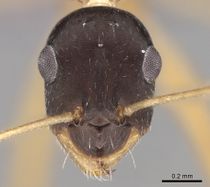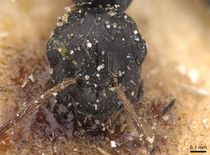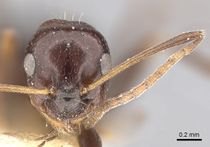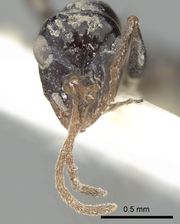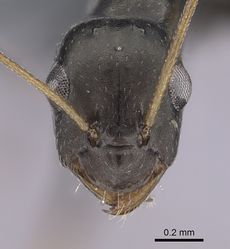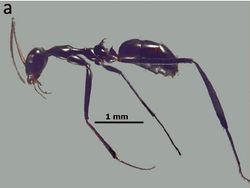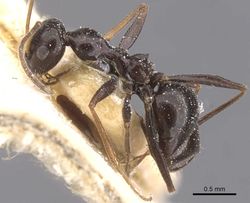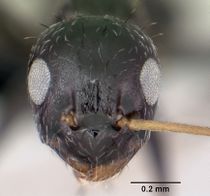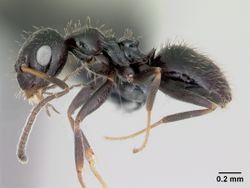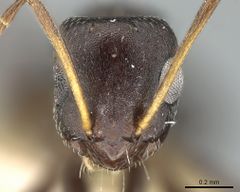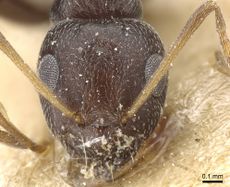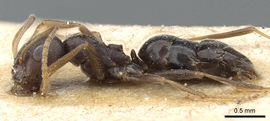Key to Arabian Lepisiota
This worker key is based on: Sharaf, M.R., Monks, J., Polaszek, A. and A.S. Aldawood. 2016. A remarkable new species of the genus Lepisiota Santschi (Hymenoptera: Formicidae) from Oman and the United Arab Emirates with a key to the Arabian species. Journal of Natural History. 50(29-30):1-13. doi:10.1080/00222933.2016.1180722.
You may also be interested in
1
- Antennal scape long, surpassing the posterior margin of head by half its length or more . . . . . 2
- Antennal scape shorter, surpassing the posterior margin of head by a third of its length or less . . . . . 18
2
return to couplet #1
- Dorsum of mesosoma and gaster without standing setae; antennal scape exceptionally long; SI ˃ 200 . . . . . 3
- Dorsum of mesosoma with at least one or two pairs of long setae on pronotum; gaster always with some projecting setae; antennal scape shorter; SI < 200 . . . . . 4
3
return to couplet #2
- Unicolourous dark brown or black-brown; body parts of moderate lengths (SI 200–205; WL 1.00) (KSA) . . . . . Lepisiota riyadha
- Bicoloured species, head and gaster brown; body exceptionally long (SI ˃ 375; WL 1.91) (Oman, UAE) . . . . . Lepisiota elegantissima
4
return to couplet #2
- Bicoloured, mesosoma paler than gaster, mainly or entirely reddish . . . . . 5
- Whole body dark except a small area of the mesonotum more or less red in a few species. . . . . . 10
5
return to couplet #4
- Mesosoma with whole dorsum covered with blunt black setae (KSA) . . . . . Lepisiota arabica
- Mesosoma with one, two or three pairs of fine setae on the pronotum . . . . . 6
6
return to couplet #5
- Body sculpture coarse, general appearance opaque . . . . . 7
- All parts of the body shining with superficial reticulate sculpture at most . . . . . 8
7
return to couplet #6
- Colour entirely black; several pairs of long, pale setae on cephalic dorsum, pronotum and gaster; petiole wide, at least 0.33 × HW (Afghanistan, India) . . . . . Lepisiota sericea
- Bicoloured species, head, mesosoma, petiole and appendages orange, gaster dark brown; body pilosity rare except for long few setae on anterior clypeal margin and sparse appressed pubescence on cephalic dorsum; petiole narrower, less than 0.30 × HW (Greece, India, Iran, Israel, Lebanon) . . . . . Lepisiota bipartita
8
return to couplet #6
- Head and mesosoma uniformly red; propodeum armed with long curved spines (Oman, Zimbabwe) . . . . . Lepisiota arenaria
- Head darker than mesosoma; propodeum simply dentate, or armed with short, straight spines . . . . . 9
9
return to couplet #8
- Head, petiole and gaster light brown, mesosoma and appendages yellow; mesonotum distinctly narrower anteriorly than posteriorly in dorsal view; propodeal and petiolar spines acute (KSA) . . . . . Lepisiota dammama
- Head, petiole and gaster dark brown contrasting with the red mesosoma; mesonotum characteristically rectangular in dorsal view; propodeal and petiolar spines blunt (Greece, Iran, Israel, KSA, Turkey) . . . . . Lepisiota dolabellae
10
return to couplet #4
- Mesosoma densely sculptured; not shining . . . . . 11
- Mesosoma superficially sculptured; at least partially shining, in some species completely shining . . . . . 12
11
return to couplet #10
- Head and mesosoma densely sculptured and completely opaque; propodeal spines long and curved; first and second gastral tergites with a few pairs of long setae located at posterior margins of tergites (Oman) . . . . . Lepisiota dhofara
- Head and mesosoma superficially sculptured and slightly shining; propodeal armature short and blunt; first and second gastral tergites completely bare (Balkan Peninsula, Central Asia, Iran, Kazakhstan, Kuwait, UAE) . . . . . Lepisiota karawaiewi
12
return to couplet #10
- Body entirely black, with slight reticulate sculpture at most and shining . . . . . 13
- Mesosoma usually with small area of mesonotum red; head and mesosoma distinctly sculptured and not shining . . . . . 17
13
return to couplet #12
- Propodeal spines short and straight, petiole dorsum narrow and rounded, with reduced armature; antennal scapes shorter, SI 150–155 (Croatia, Egypt, Greece, Iberian Peninsula, Italy, Kyrgyzstan, Macedonia, Montenegro, Oman, UAE) . . . . . Lepisiota nigra
- Propodeal and petiolar armature both well developed with long curved spines; antennal scape long, SI 165–200 . . . . . 14
14
- Propodeum and first gastral tergite with some fine surface sculpture; first gastral tergite with characteristic violet reflection; S1 195–200 (Egypt, Israel, KSA, UAE) . . . . . Lepisiota opaciventris
- Whole body smooth; first gastral tergite without reflection of any type; SI 165–195 . . . . . 15
15
return to couplet #14
- Propodeal short, less than 0.10 mm, moderately curved; antennal scape long, SI 175–195 (Yemen, Eritrea, Israel, UAE) . . . . . Lepisiota gracilicornis
- Propodeal spines long, more than 0.12 mm, and distinctly curved; antennal scape shorter, SI 165–170 . . . . . 16
16
return to couplet #15
- Body dark brown; propodeal spines shorter and slightly curved, in profile appearing at level of the petiolar spines; body slightly shining; scape shorter (SI 170), cephalic index smaller (CI 79), petiolar height lower in profile (0.41); appressed pubescence abundant on body (Kazakhstan, Oman, KSA, Socotra) . . . . . Lepisiota spinisquama
- Body black, propodeal spines longer and more strongly curved, in profile appearing much higher than level of petiolar spines; body more strongly shining; scape longer (SI 230–233), cephalic index greater (CI 86–88), petiolar height larger in profile (0.25–0.37); pubescence on body scattered (Oman, UAE) . . . . . Lepisiota omanensis
17
return to couplet #12
- Pronotum with one pair of setae; petiole dorsum distinctly dentate (widespread in Palaearctic region) . . . . . Lepisiota frauenfeldi
- Pronotum without setae; petiole dorsum feebly incavate or narrowly rounded without teeth (Tunisia, UAE) . . . . . Lepisiota nigrescens
18
return to couplet #1
- Head and gaster smooth and shining with only faint sculpture . . . . . 19
- Head and gaster distinctly sculptured . . . . . 21
19
return to couplet #18
- Whole body dorsum covered with blunt black setae (Namibia, Somalia, Yemen, Zimbabwe) . . . . . Lepisiota validiuscula
- Mesosoma with pale, thin setae . . . . . 20
20
return to couplet #19
- Body pilosity short, restricted to a few pairs, sparse on propodeum and gastral tergites; pronotum without setae; whole body smooth and shining (Bangladesh, India, Kenya, KSA, Lesotho, Somalia, Zimbabwe) . . . . . Lepisiota simplex
- Body pilosity long and abundant, especially on gaster; pronotum with five pairs of hairs; whole body smooth except mesopleura transversely striate, general appearance moderately shining (Guinea, Israel, Kenya, KSA, Somalia, Oman, Yemen . . . . . Lepisiota canescens
21
return to couplet #18
- Whole mesosomal dorsum covered with long pale setae (Eritrea, Israel, KSA, Oman, Yemen) . . . . . Lepisiota obtusa
- Pilosity on mesosomal dorsum either restricted to pronotum or absent . . . . . 22
22
return to couplet #21
- Petiolar angles produced into long spines . . . . . 23
- Petiole dorsum flat, emarginate or dentate at most . . . . . 24
23
return to couplet #22
- Larger species, TL 3.30; head superficially sculptured, slightly shining; in full-face view posterior margin of head strongly convex and with three pairs of long, stiff setae; mesosoma with several pairs of setae, smooth and shining, except for transverse striations on mesopleura (Democratic Republic of Congo, Kenya, Yemen) . . . . . Lepisiota incisa
- Smaller species, TL 2.12; head strongly sculptured, completely opaque; in full-face view posterior margin of head straight, without setae; mesosoma without setae, entirely, and densely sculptured (Djibouti, KSA, Oman, Somalia, Yemen) . . . . . Lepisiota carbonaria
24
return to couplet #22
- Petiolar armature well developed; gaster finely and densely granulate, completely opaque (Eritrea, Ethiopia, KSA, Yemen) . . . . . Lepisiota erythraea
- Petiolar dorsum shallowly emarginate; gaster superficially sculptured, slightly but distinctly shining . . . . . 25
25
return to couplet #24
- Mesosoma red; first gastral tergite with six pairs of long, pale setae located dorsally, posterior margin with several pairs; smaller species (TL 2.80), scape longer (SI 123) and head slightly narrower (HW 0.57) (Yemen) . . . . . Lepisiota harteni
- Mesosoma brown; pilosity of first gastral restricted to posterior margin; larger species (TL 3.20), scape shorter (SI 111), head wider (HW 0.63) (KSA, Oman, Somalia) . . . . . Lepisiota carbonaria


